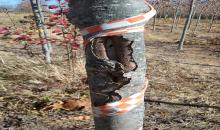Chrysobothris femorata(CHRBFE)
Photos
For publication in journals, books or magazines, permission should be obtained from the original photographers with a copy to EPPO.

Bark damage on trunk of nursery tree. Splitting
Courtesy: Jason Oliver (Tennessee State University, USA)
Bark damage on trunk of nursery tree. Sunken bark and serpentine gallery visible
Courtesy: Jason Oliver (Tennessee State University, USA)
18-cm long larval gallery in Acer rubrum ‘Franksred’ (red maple) with the bark removed. Note the gradually enlarging gallery from start to end.
Courtesy: Jason Oliver (Tennessee State University, USA)
Two larval galleries in Acer rubrum ‘Franksred’ (red maple) with the bark removed. Note the gradually enlarging galleries from start to end.
Courtesy: Jason Oliver (Tennessee State University, USA)
Adult of Chrysobothris femorata (view from above)
Courtesy: Joshua Basham (Tennessee State University [currently USDA-APHIS], USA)
Basal shoots formed following girdling damage, with bark cracking and evidence of frass
Courtesy: Jason Oliver (Tennessee State University, USA)
Basal shoot formed following girdling damage, with bark cracking and evidence of frass
Courtesy: Jason Oliver (Tennessee State University, USA)
Bark damage on the trunk of nursery trees revealing flatheaded borer excrement. Splitting/flaking (note possible 2 adult exit holes)
Courtesy: Jason Oliver (Tennessee State University, USA)
Bark damage on the trunk of nursery trees revealing flatheaded borer excrement. Splitting/flaking
Courtesy: Nadeer Youssef (Tennessee State University, USA)
Bark damage on trunk of nursery tree. Splitting and older damage evidenced by some bark callusing (note d-shaped exit hole in middle)
Courtesy: Jason Oliver (Tennessee State University, USA)
Circular gallery on an approximately 5-year old tree, bark removed
Courtesy: Jason Oliver (Tennessee State University, USA)









